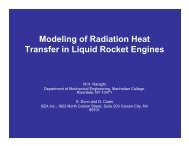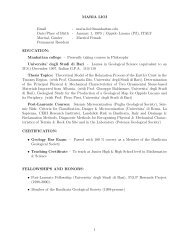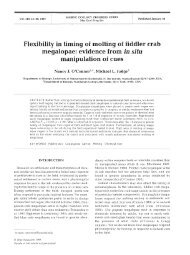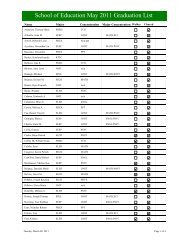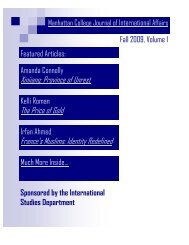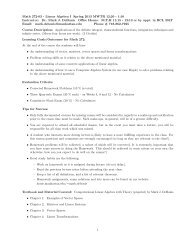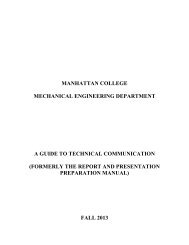4.1 Thermodynamic Analysis of Control Volumes
4.1 Thermodynamic Analysis of Control Volumes
4.1 Thermodynamic Analysis of Control Volumes
You also want an ePaper? Increase the reach of your titles
YUMPU automatically turns print PDFs into web optimized ePapers that Google loves.
‚ Ẇ = 0: Heat exchangers typically involve no work interactions.‚ KE PE 0: Changes in these forms <strong>of</strong> energy are usually negligible.Pipe and Duct Flow:The transport <strong>of</strong> liquids or gases in pipes and ducts is <strong>of</strong> great importance in many engineeringapplications. When flow through pipe or ducts is analyzed, the following points should be considered:‚ Q . 0: Under normal operating conditions, the amount <strong>of</strong> heat gained or lost by the fluid canbe very significant, particularly if the pipe or duct is long and not insulated.‚ Ẇ 0: If the control volume involves a heating section (electric wires, a fan, or a pump (shaft),the work interaction should be considered.‚ KE 0: For constant-diameter pipes/ducts, this energy term is usually negligible.‚ PE 0: Potential energy consideration are important when a fluid is pump through greatelevation changes.4.4 Unsteady-Flow ProcessesMany processes <strong>of</strong> engineering interest involve changes within the control volume with time.Such processes are called unsteady-flow, or transient-flow processes.Important point!The steady-flow relations developed in the previous sections are not applicable tothese processes!When an unsteady-flow process is analyzed, it is important to keep track <strong>of</strong> the mass and energycontents <strong>of</strong> the control volume as well as the energy interactions across the boundary. Some familiarunsteady flow processes are the charging <strong>of</strong> rigid vessels from supply lines, discharging a fluid from apressure vessel, inflating tires or balloons, and even cooking with an ordinary pressure cooker. Unlikesteady-flow processes, unsteady-flow processes start and end over a finite time period ∆t. Anotherdifference between steady and unsteady-flow processes is that steady-flow systems are fixed in space, insize, and in shape. Unsteady -flow systems, however, are not. They are usually stationary, but involvemoving boundaries (boundary work!)Conservation <strong>of</strong> Mass:Unlike the case <strong>of</strong> steady-flow processes, the amount <strong>of</strong> mass within the control volume doeschange with time during an unsteady-flow process. The degree <strong>of</strong> change depends on the amount <strong>of</strong>mass entering and leaving the control volume during the process. The conservation <strong>of</strong> massprinciple for unsteady-flow processes is mathematically stated as ...ENGS205--Introductory <strong>Thermodynamic</strong>s page 39



